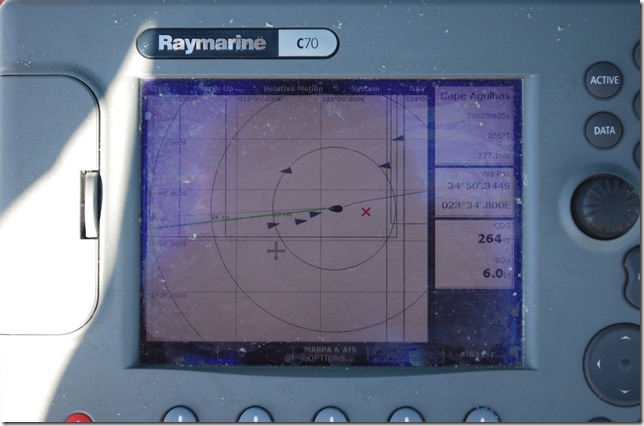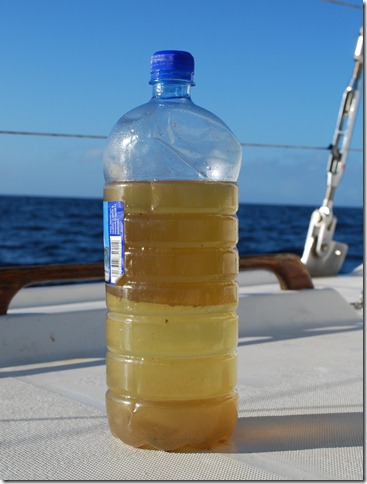Lat: 35 00.934′ S
Lon: 22 26.494′ E
Yesterday ended up being a pretty nice day weather-wise. The sun was out most of the day, seas were down, and it was cool, but not cold. Around dusk, the wind had dropped enough that boat speed was hovering around 4 knots, so I needed to do something. Normally I’d put up the spinnaker, but being singlehanded with night coming on, I decided to go for some motorsailing instead. The port engine had only been running a couple of minutes when I heard it start losing power, dropping RPMs, and beginning to die. I quickly shut it off, tried restarting it, and got the same result (not sure what I was trying to prove there). Off went the watch clothes, on went the work clothes, and I crawled down into the engine room with a headlamp. The transparent bowl at the bottom of the combination fuel/water and fuel filter had generous amounts of something that looked like mucus in it. I soon figured out that if I squeezed the manual pump fuel bulb I have in-line, more mucus-looking stuff would dump into the filter, but the engine would only run for a minute or two until I had to pump again, and it was starting to sound a little loud.
Ok. At least I know what’s wrong now — bad fuel and a clogged fuel filter. I’m usually pretty careful about fuel, but I have had a couple of incidents lately, with the port tank, that aren’t (or maybe are) characteristic of me. One was buying 5 gallons of fuel off Garth in Mozambique. He needed the cash and I could always use a little fuel, but I would normally only buy fuel from someplace I expected to have clean, fresh fuel. The second one was accidentally leaving the fuel fill cap off overnight after getting distracted while adding a jug of fuel in Durban near sunset. It sprinkled a little bit, but I don’t remember it raining too much.
Whatever the cause, I gave it up for the night and settled for 3-4 knots on the jib as the wind was too far aft to use the main. I didn’t want to run the other engine because one engine down is halfway to no engine at all, and I’d rather not push it. The effect of sleeping so little for a day and a half had caught up with me. Even with my watch being right beside my ear, it never woke me up once. I found myself waking up 1-3 times an hour, but never because the alarm was going off.
Luckily, the AIS seems to be working again, which makes things much safer. My current theory is that the problem was humidity messing up the AIS RF electronics, but we’ll see. I moved some canvas covers and rags that were getting wet so that now any moisture in that compartment drains out and it seems to have made a difference.
Here’s the basic math behind not getting run over (which did happen to a boat out here in the last year). Large ocean-going ships generally do 14-17 knots. Our speed is variable, but it’s not unusual to be doing 7 knots here due to strong winds or current. I’m essentially trying to cover the same route they’re covering, so they’re always coming up from behind or ahead. From behind, they’re closing at around 10 knots, which is slow enough for me to see them before anything can happen, but from ahead they’re closing at 24 knots or more sometimes. In good conditions (good visibility, calm seas, awake & alert person looking, and spending a bit of time looking and re-looking) you can spot the superstructure of a large ship at roughly 8-11 miles. Between 5-8 miles, the hull becomes visible, making it a much larger object on the horizon and one you’re not likely to miss. The issue is that at 24 knots, you’re getting a mile closer to each other every 2.5 minutes, or 6 miles closer between every 15 minutes check. It’s not uncommon to miss seeing a ship due to poor visibility, fatigue, a tanker’s low profile, etc. when it’s 6-8 miles away and then come back out 15 minutes later to find it right on top of you. If you miss one 15 minute check, a ship that wasn’t visible last time you looked can now be past you. This is where the AIS makes itself very useful. In addition to telling you exactly where each ship is headed and sounding an alarm if you’re on a collision course, it can see much farther than the naked eye, easily picking up ships 15-20+ miles out, giving you a warning time that’s much longer and letting you concentrate on the occasional ship that is going to pass close by instead of visually tracking every ship you see to determine whether it’s coming toward you. You can see why having it working again has been a big deal. The local fishing boats never seem to be fitted with an AIS transmitter, but they’re always well lit, generally aren’t moving too fast, and theoretically are keeping a good watch.
 A common sight – half a dozen ships and three coming my way
A common sight – half a dozen ships and three coming my way
 For all the Hannibal, Palmyra, & Quincy folks – the Mark Twain loaded with containers the size of railway cars
For all the Hannibal, Palmyra, & Quincy folks – the Mark Twain loaded with containers the size of railway cars
After getting more sleep than anticipated, I was ready to tackle the port engine problem not too long after sunrise. I anticipated a lot of work filtering fuel, making a small clean-fuel tank from a jerry can, and bleeding the engine, but I started by draining the filter/separator and immediately saw the problem — the thing was almost entirely filled with water!. Fuel floats on top of water, and there’s a transparent bowl at the bottom of the filter where the water collects. You should see a line between the two liquids if any water is present and if so, you can open a nipple at the bottom that lets the water drain out from the bottom. This is part of the engine check I do before each passage, but somehow the bowl had gone from no water to completely full of water, evidently between Durban and here, so that I never saw a line and realized it needed to be drained. In all, the contents of the filter were 80-90% water. No wonder the engine wasn’t happy. I have a case of fuel filters on hand for just this sort of emergency, and after flushing and cleaning the filter housing, replacing the filter element, and bleeding the air from the fuel lines, it eventually started up. It had a bit of white smoke in the exhaust for a minute or two, but then ran fine for over an hour and sounded as good as ever.
 Filter contents: bottom half water, top half fuel (most of the fuel was from flushing, not the filter drain)
Filter contents: bottom half water, top half fuel (most of the fuel was from flushing, not the filter drain)
Within a couple of hours, the wind started to pick up a little bit and since then I’ve been doing 5-7+ knots on a beam reach with the full main and jib. The morning was clear again, warmer than yesterday, and the seas were pretty calm. This afternoon some low cloud cover rolled in, but the seas have stayed calm. I’ve sailed a course that’s almost 50 miles offshore now so that as the wind comes from the SSE and strengthens I’ll still have it aft of the beam as I near Cape Agulhas. It’s hard to say what my timing will be like at this point, but it looks like there will be a pretty good blow from the SE/SSE once I round the cape (I’ll be going NW then so should be fine), so I’m guessing I’ll make Simon’s Town in less than 48 hours.

